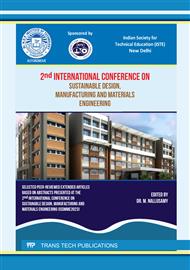p.141
p.149
p.155
p.167
p.175
p.183
p.189
p.197
p.209
Implementation of 5s Concept to Improve Productivity in a Fabrication Industry
Abstract:
In the current unstable economy, every fabricating sector has continuously made attempts to ensure its survival by adopting new and effective procedures to improve productivity. The industry's production issues were brought on by poor equipment handling, a lack of inventory classification, and an unorganized storage area. So, the objective is to reduce the waste, risk of labour, production cost, and time, and increase the workspace and production, thus gradually influencing the industry's overall profit. It can be achieved by implementing the most relevant lean techniques. Lean, an emerging technology, is used in manufacturing sectors to find and eliminate waste and increase efficiency. It is a completely customer-based strategy that concentrates on the value chain and its improvement. In this paper, lean analysis suggests using a 5S for restructuring the storage area, Kanban, and Kaizen for properly handling waste. It is observed that there is a significant improvement after this implementation.
Info:
Periodical:
Pages:
175-180
Citation:
Online since:
March 2024
Price:
Сopyright:
© 2024 Trans Tech Publications Ltd. All Rights Reserved
Share:
Citation:



